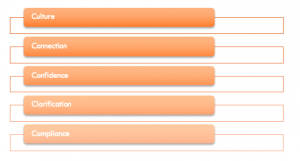 By: Talya N. Bauer, Ph.D.
By: Talya N. Bauer, Ph.D.
Chief Scientific Advisor, Preppio
Onboarding is the process of helping new employees learn the requirements, expectations, and culture of their new organizations. It is a process that is critical for getting new employees off to a strong and productive start and when done well, it leads to employees feeling more clear on role expectations, connected to their colleagues, confident in their ability to successfully do their job and navigate the organization and to understand and embody the organization’s culture. It also means that employees are more engaged, have better job attitudes, and are less likely to leave the organization. I began studying onboarding over two decades ago.
In 2010, I created the “C’s of Onboarding” framework compliance, clarification, confidence, connection, and culture. Compliance refers to things that must be done when new employees start things like getting paperwork completed, the badging process, and provisioning tasks like equipping new employees with computers and phones as well as a workspace. Clarification refers to how well new employees understand their roles and performance expectations. Confidence refers to how much new employees feel like they can do the job well and tackle new challenges. Connection refers to how accepted and valued new employees feel. Culture refers to how well new employees understand the norms, values, stories, and symbols of their new organization.

Post-COVID, onboarding will continue to be an important part of successful organizations and their success, but a more pressing concern is that of reboarding. Millions of people have been placed on work-from-home (WFH) status due to company and government decisions for sheltering in place and social distancing. Before COVID, it was not unusual for some people in some industries to work remotely at least a few days per week. Now, the droves of new workers have learned how to successfully navigate the challenges of working remotely. This has led organizations such as Twitter to announce that employees will have a choice to return to the office or continue working from home forever if they are able.[1] And, in the short run, large organizations such as Google and Facebook have announced that employees will be working remotely at least until the end of 2020. Estimates range from 25 to 41% of employees estimated to work-from-home post-COVID.[2]
As the Twitter announcement indicates, returning back to work post-COVID will not be business as usual. In order to prepare for reboarding, organizations should consider key factors, and looking to best practices for onboarding can be helpful in addressing reboarding post-COVID. While there are many factors to consider, I am focusing on the following employee needs following the 5 C’s of Onboarding framework to help with employees returning to physical offices as well as furloughed employees returning to work.
Post-COVID Reboarding Considerations and Best Practices
- COMPLIANCE:
- Provide clear guidance regarding new rules and policies– A huge part of new employee onboarding is learning what the requirements are for the new job and meeting those. This might include filling out paperwork or signing legal documents and forms with HR. Post-COVID, organizations are likely to have new policies and procedures in place. These new rules will
Focus on health and safety– Related to the need for clear guidance regarding new rules and policies, organizations that focus on the health and safety of their returning employees are likely to be concerned for their physical health and safety. Organizations that make it clear, through their words and actions, that this is a priority for them as well will go a long way toward helping employees re-engage and feel a sense of obligation to reciprocate to support their organization.
- CLARITY:
- Support work-family considerations– The lines between work and family have become more and more blurred over time with the increase in online access and cell phones making us available more now than ever. However, physically being at work did help with the clarity in terms of such lines. During the COVID pandemic, this has not been the case for many employees who have worked while juggling family members, roommates, and even pets in real-time along with their work. We have all seen meetings and interviews with pets barking and kids interrupting their parents with a question. As employees return back to work, part of the challenge of reboarding will be helping them to navigate these blurred lines now that “professionalism” has been tempered with “humanism” and the idea that we are all doing the best we can in terms of our work and our families.
- CONNECTION:
- Provide emotional support– Helping employees engaging in reboarding the organization post-COVID will require a focus on helping employees manage their emotions and anxiety. More now than ever, employee assistance programs and other benefits are necessary to offer and make accessible to employees who may need them. Openly addressing the issue and normalizing emotions is a potentially useful and healthy approach to help employees get back to normal and feel more connected to one another and the organization.
- CONFIDENCE:
- Rebuild trust– Some organizations have done a good job of showing empathetic leadership in the face of challenging circumstances. Others have not done as well. Regardless, the physical distance and record global unemployment we’ve experienced as a society will mean that some confidence and trust has been lost and will need to be rebuilt so that it does not erode further.
- CULTURE:
- Support cultural evolution– Organizational culture is not a static thing. It is intangible and it evolves. Every new employee who joins an organization is influenced by it and also has an influence upon it. Post-COVID, a big part of reboarding success will depend on how well an organization supports cultural evolution. In other words, the creation of new norms, new stories, new rituals, and new ways of getting work done and connecting with one another at work. While this cultural evolution will happen with or without organizational support, those who are able to help facilitate a healthy dialog about cultural changes and evolution will be poised to come out stronger on the other end of the pandemic recovery process.
Conclusion
The points provided here are easier said than done. They are worth the effort. By focusing on these considerations and best practices will likely set organizations apart from those who evolve and emerge stronger than before the pandemic and those who see engagement erode and employees leave as soon as other opportunities are available.
Need help reboarding your employees?
We offer free help with reboarding strategy and content.
Get Personalized Help